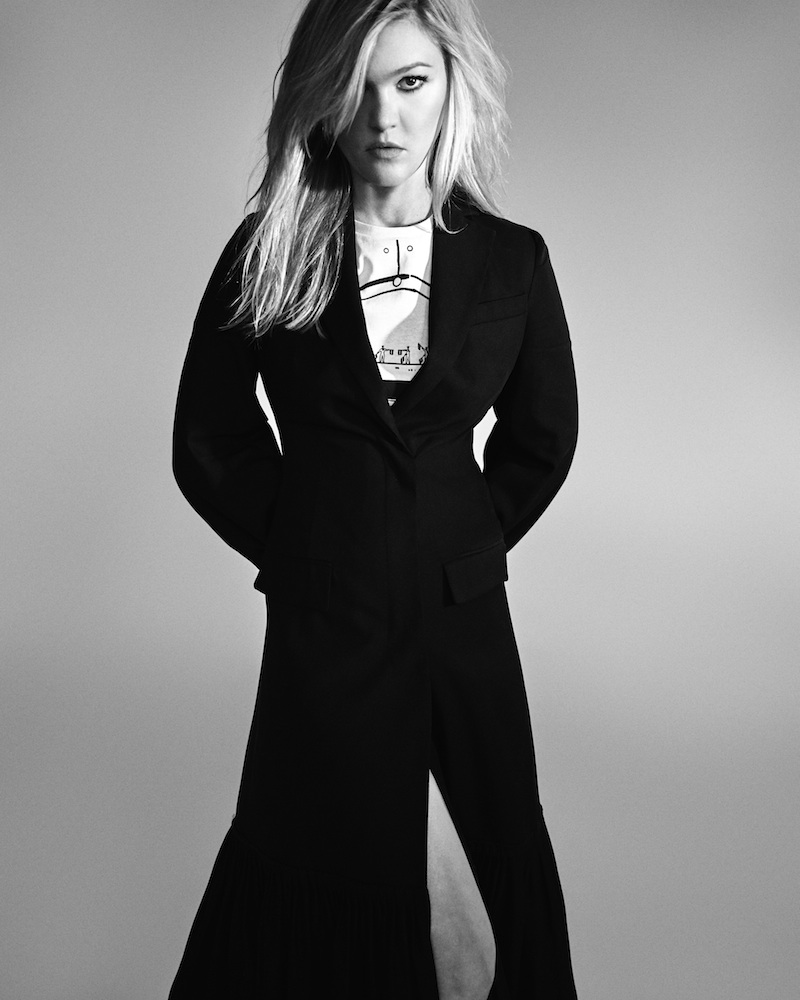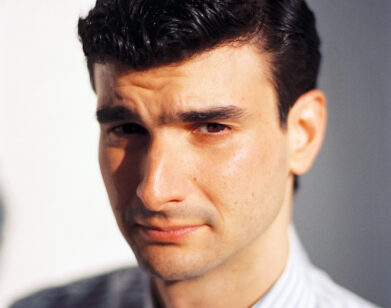Julia Stiles
JULIA STILES IN NEW YORK, MAY 2016. PHOTOS: JUSTIN HOLLAR. STYLING: ANNA KATSANIS/ATELIER MANAGEMENT. HAIR: NATE ROSENKRANZ/ HONEY ARTISTS USING ALTERNA HAIR CARE. MAKEUP: AYA KOMATSU/BRIDGE ARTISTS. MANICURE: YUKO WADA/ATELIER MANAGEMENT USING DIOR VERNIS. STYLING ASSISTANT: ERICA PITNICK.
When Julia Stiles first signed on to play CIA employee Nicky Parsons in The Bourne Identity (2002), she was a college student at Columbia University. A native New Yorker, Stiles had been acting professionally since she was 11. Thanks to roles in teen movies like the pithy comedy 10 Things I Hate About You (1999) and emotional drama Save the Last Dance (2001), she was something of a thinking-teen’s idol at the time.
For a rising star like Stiles, Nicky was not a particularly large part—she was supposed to die at the end of the film and it wasn’t until filming finished that director Doug Liman recut her final scene—but Stiles was intrigued by star Matt Damon. “He wasn’t the obvious choice at the time,” she recalls over the phone. “I remember pausing for a second wondering if I was going to miss too much school, but I quickly ignored that and decided that it would be more fun to go to Prague and Paris.”
Fourteen years later, Stiles is the only actor except for Damon himself to appear in all four Jason Bourne films. In Jason Bourne, the franchise’s latest installment, out today, Nicky is something of a new woman: determined and mature, she’s no longer just a government pencil pusher. “She’s become quite ideologically driven,” says Stiles. “She launches the whole movie…it was nice to see her not be obedient anymore.”
Later this summer, Stiles will move to Nice, France to begin working on a new Neil Jordan miniseries called Riviera. “Neil’s idea was that behind every great fortune is a great crime, and I play an American married to this billionaire,” she explains. “It’s a very glamorous setting, but underneath there’s a lot of corruption and dirty deeds. In the first episode, [my character’s] husband is murdered,” she continues. “In inheriting his estate, she’s discovering the ways that he lied to her and the things he was covering up.”
EMMA BROWN: Nicky has more to do in this film.
STILES: Yeah, this time was a turn for Nicky. She was in hiding when we left her in The Bourne Ultimatum (2007), and in the eight years that have passed since then she’s been running for her life. She’s become more defiant and she’s turned into quite a dissident. She’s been disillusioned by the agency she’s devoted her life to and wants to do something about it. In order to put a stop to it, she’s decided she’s going to leak information she has about the operations that they’re running.
BROWN: Did they tell you that she was going to have a different role in this film before they sent you the script or was it a nice surprise?
STILES: I found out they were doing another one and I was waiting for the script. When Paul [Greengrass] was writing, he’d send me story ideas that he had. He was particularly interested in social movements and revolutions that had been happening all over the world, and how computers and the internet had helped those movements. He encouraged me to read a book about Anonymous, the hacker group called “white hat” hackers, meaning they’re driven by ideology and social disruption as opposed to just greed. Then I was happy when I read the script—the first version they sent me—to see that before, there’s some humanity too. She tracks Jason Bourne down because she really cares about him and wants to share personal information that she thinks might help him. It was nice that there was a reference to the relationship they have and the fact that they’re allies in a world where they don’t have any other allies. It’s very subtle—it’s actually without dialogue. It’s up to each viewer to interpret for themselves, but there’s a moment of recognition between the two of them. I do think it’s powerful even without words.
BROWN: Did it feel like you were getting back into a character or, because of the things she’s gone through in the last eight years, did she feel like a new character?
STILES: It felt like revisiting a style in terms of delivery and how these people speak and the world that they live in. It did feel new to me because I wasn’t taking orders anymore. She’s a lot less reactive. She’s a lot more proactive. Also, she has nothing to lose; she’s in hiding and she’s willing to risk her life. She’s a lot tougher and more fearless than she’s been in previous movies.
BROWN: Are you someone who likes to do more takes if possible?
STILES: Yes, but the thing with the Bourne movies is that they’re so big in scope and the production value is so high and it takes so much organization. In the opening sequence, for instance, the safe meeting place Nicky chooses is in the middle of a riot in Athens, Greece. The idea is that in the middle of that chaos and violence, they have a safe cover. The amount of work that goes into organizing something like that makes it so that you don’t want to be the one person to mess it up. They shoot quite quickly, these films. I do think that the more takes you have the more opportunity to experiment [but] at a certain point, there are diminishing returns. There’s only so much variety you offer.
BROWN: I actually saw you onstage in London a long time ago in Oleanna with Aaron Eckhart. I didn’t realize you had did the play again a few years later in New York.
STILES: I did a different production with a different director and Bill Pullman. Oleanna—the one you saw—we were doing right after Bourne Identity or right after it came out. Years had passed, and when they were going to do a production of it in New York and asked me to read for it I thought, “Why would I want to do this play again?” It’s because I never felt like I got it right. It’s rich, but there’s a lot of room for interpretation, surprisingly. Just by virtue of having a different actor in the opposite role a lot changes. Bill Pullman is older than Aaron Eckhart—although I was older too—and the age difference changes the play. My perspective on those issues had changed a lot. Without going into nerdy details about that play, there was something that still stuck with me. I still had the same joy in that dialogue and David Mamet’s rhythm in terms of his writing. I felt like there was still something to explore.
BROWN: Have you felt that way about other plays or movies? When you finish a project, do you generally feel like, “I’ve got it; I can move on”?
STILES: I think really only with theater. With film, so much is in the director’s hands. Once something is cut together—unless you’re in the editing room—you don’t really remember what the alternatives are. The exercise in theater is night after night you are doing the same play, but you have another opportunity to explore. It changes nightly even because of the audience and your day going into the evening of the performance. With film it’s much more controlled.
BROWN: Did you go to the theater a lot when you were growing up in New York?
STILES: I did. My grandmother took me to a lot of theater. I was exposed to performance quite a bit—everything from Broadway to off-Broadway and dance and music as well. I was very lucky that way. It was a very rich childhood.
BROWN: Do you remember the first performance you saw that really resonated with you?
STILES: I remember seeing Janet McTeer in A Doll’s House. My grandmother took me and we had seats in the very back row, but her performance was so powerful—it was very accessible. I felt like I was much closer than I was.
BROWN: You started acting when you were quite young, was there ever a moment in your career where you felt like you became an adult actor, or you decided again that this is what you wanted to do as an adult?
STILES: I think it’s been in the last few years. I did a run of a play over the summer in a really tiny theater in New York and that was rejuvenating for me. I directed a short series for Hulu called Paloma and being in an editing room, I learned a lot about acting. It gave me a new bolt of energy in terms of my interest in filmmaking because it made me realize how collaborative filmmaking can be and also that you’re not just limited to one job. Actors can write and produce too. Then when I was working on Jason Bourne—having had that experience—instead of going back to my trailer and being separate from everyone else, I would sit behind the monitor and watch Paul Greengrass work and be much more included in the process. That was new for me and really enriching.
BROWN: What, ideally, do you want out of a director? Do you want someone who gives you really specific feedback?
STILES: I like a director who is very observant and is watching what I’m doing and noticing what I’m doing, but is giving me time to figure it out. They don’t jump right in and give you a note before you’ve had time to really search on your own with how to do a scene. I like a director that encourages me to be playful. I don’t really like being restricted or controlled by a director.
BROWN: Do you feel like you’re constantly getting better as an actor?
STILES: In my early career, I look at that time as a series of trial and error and learning as I go. Now I feel like I have a skill set, but every experience is different and there’s always room for improvement.
BROWN: Do you have a fear of women in their mid or late 20s, because you know they’re going to gush about 10 Things I Hate About You?
STILES: I don’t have a fear of it. I think it’s really sweet. I think it’s really special to be a part of something that people are still watching or thinking about or interested in, or remember fondly many years later. I don’t think it’s annoying at all.
JASON BOURNE IS OUT TODAY, JULY 29.







